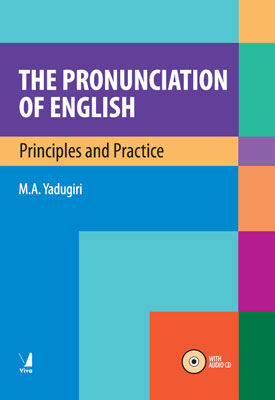The Pronunciation of English, with audio CD
The Pronunciation of English, with audio CD
Principles and Practice
₹625.50 ₹695.00 Save: ₹69.50 (10%)
Go to cartISBN: 9788130929361
Bind: Paperback
Year: 2018
Pages: 400
Size: 171 x 241 mm
Publisher: Viva Books Originals
Sales Territory: Worldwide
Description:
This course book covers all aspects of English pronunciation including consonants, vowels, word stress, and features of connected speech such as rhythm, prominence and intonation. The description of the various features is clear and factual with several examples, which the learners can listen to on the audio CD. The different types of exercises at the end of each unit in a chapter give the learners both listening and speaking practice and also help in understanding the principles of English pronunciation. The chapters begin with a preview and end with a summary to facilitate systematic learning. The book also has a glossary of specialized terms, a list of books and online sources for further study and an answer key.
Special features of the book:
Separate and highlighted presentation of:
• the important differences between British and American pronunciation with examples spoken by British and American speakers on the audio CD
• the characteristic features of Indian pronunciation
• crucial points about English pronunciation that learners should remember in pronunciation practice
• information on useful technical terms and distinctions in Phonetics and Phonology
A unique feature of the book is the presentation of jokes, fables and passages of general interest at the end of every chapter, each read by three speakers • British, American, and Indian • which show how specific features of pronunciation are used in the context of a meaningful self-contained text and also how British, American and Indian pronunciations differ.
Contents:
Introduction • Towards an awareness of English pronunciation • Understanding speech sounds • Why individual sounds are important • How we produce speech sounds • How we identify sounds of English • How we represent sounds of English in writing • English consonants • How we describe and classify English consonants • How combining with other sounds affects pronunciation of consonants • How grammar affects pronunciation of consonants • How spelling affects pronunciation of consonants • English vowels • How we describe and classify English vowels • How combining with other sounds affects pronunciation of vowels • How grammar affects pronunciation of vowels • How spelling affects pronunciation of vowels • English syllables • How we define the syllable and analyse its structure • Consonant clusters and their pronunciation • Syllabic consonants and their pronunciation • Word stress • How stressed syllables are different from unstressed syllables • Word stress and degrees of stress within a word • Important features in deciding word stress placement • Stress in monosyllabic words • Stress in words of two or three syllables • Stress in nouns, adjectives and verbs • Stress in phrasal verbs • Stress in complex words-1 • Stress in complex words-2 • Stress in compound words • Stress in reflexive pronouns, numbers and abbreviations • Connected speech • I Rhythm and adjustments in pronunciation • How rhythm works in English • Adjustments in connected speech • Linking • Assimilation • Elision • Contraction • Use of weak forms • Connected speech • II Prominence and intonation • How we divide speech into tone units • How we decide to place prominence or tonic stress in a tone unit • What is intonation and what are the tones used in English? • Intonation and grammar • Intonation and emotions and attitudes of the speaker • Intonation and information management • Intonation and conversation management • Step-ups and step-downs in pitch • Speaking activities focusing on overall ability • Appendix • Glossary • Further reading • Key338
Talk
Newspaper - 22/Mar/2013

About the Author:
M.A.Yadugiri, formerly Professor of English, Bangalore University, has a Ph.D. in Linguistics-Stylistics from the Indian Institute of Science, Bangalore. She has taught postgraduate courses on Modern Linguistics, Modern English Structure and Usage and Stylistics in Bangalore University for more than 20 years and has guided several M.Phil. and Ph.D. students in the areas of English Linguistics, English for Specific Purposes and Stylistics. As Longman Fellow in the English Language, she has taught and researched in the University of London and as Morley Scholar, she has done research in the area of English for Academic Purposes in the English Language Institute, University of Michigan. She has also taught courses on Communication Skills for Managers in the Indian Institute of Science and top management institutes. She has published articles on ELT, ESP, and Stylistics in national and international journals. She is the author of Making Sense of English, and the co-author of English for Law.



